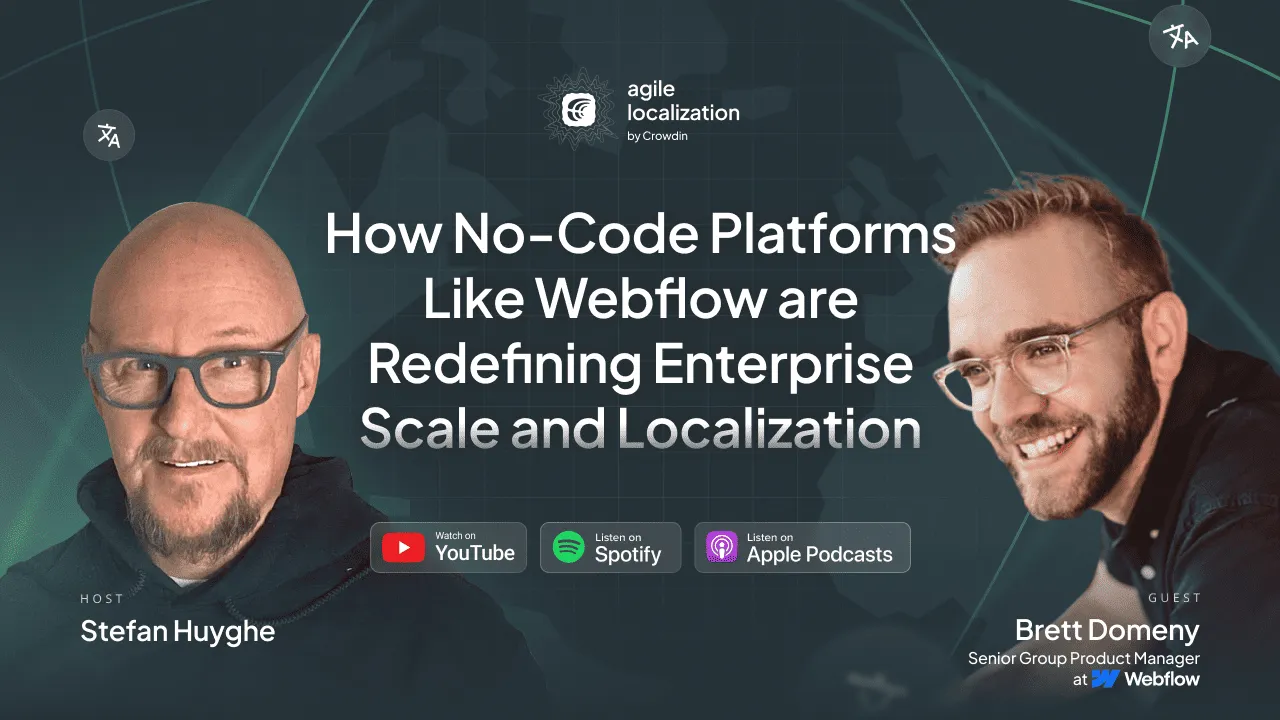When people think of no-code, they often picture tools for scrappy startups or DIY website builders. But what happens when no-code platforms mature and suddenly some of the world’s largest enterprises are running their global digital presence without writing code?
That’s the world Brett Domeny, Senior Group Product Manager at Webflow, lives in every day. In his conversation with Stefan Huyghe on The Agile Localization Podcast, Brett explains how no-code is no longer about quick fixes; it’s about giving development superpowers to everyone.
Listen to the new episode on:
No-Code Isn’t Just for Startups Anymore
One of the biggest misconceptions about no-code is that it can’t handle scale. Early tools were limited to pieces and parts, basic design changes, or simple drag-and-drop site builders. That led to the belief that enterprises still needed entirely custom-coded platforms to get flexibility and power.
Webflow’s approach challenges that idea. According to Brett, the company built its platform with three tiers in mind:
- No-code for marketers and non-developers to build and iterate quickly.
- Low-code for teams that want to extend functionality with small customizations.
- Pro-code for developers who integrate advanced features or connect APIs.
This layered approach means enterprises can empower their marketing and product teams to move faster, while developers focus on strategic projects, not minor content updates.
Redefining Localization
Global enterprises can’t treat localization as an afterthought. For Brett, the key is recognizing that translation is just one part of a much larger picture of website localization.
Webflow’s philosophy is end-to-end localization, which spans three core areas:
- Design and content localization: Brands can adapt layouts, images, and messaging per market instead of forcing one-size-fits-all templates.
- Flexible translation workflows: Teams can use Webflow’s built-in tools or integrate with partners like Crowdin for advanced translation and review processes.
- Hosting and delivery: Localized content needs to be SEO and AI-search friendly, with infrastructure that automatically generates sitemaps and delivers content globally.
Think of translation as a small circle within a much larger sphere labeled localization. Design choices, user experiences, and cultural context matter just as much as words on the page.
Crowdin + Webflow
If localization requires nuance, then extensibility is non-negotiable. Brett highlighted Webflow’s extensibility by default mindset. Instead of building one rigid solution, the platform provides APIs and connectors so companies can integrate best-in-class tools.
That’s where Crowdin comes in. Many global enterprises already rely on Crowdin for specialized translation workflows, so Webflow built a turnkey app for integration. Customers can sync translations between Crowdin and Webflow with just a few clicks.
For enterprise teams, that composability means freedom: choose the best tools, plug them together, and stay agile as needs evolve.
Balancing Short-Term Needs with Long-Term Vision
Product managers face a constant tension: deliver immediate customer value or invest in the North Star vision. Brett’s strategy is to balance both.
He describes it as hiking toward a destination. You need a sense of direction, but also the discipline to take the right immediate steps. Sometimes that means big foundational projects; other times, it’s quick wins that make workflows easier.
The rise of AI underscores this balance. Generative tools like ChatGPT are transforming how people search, consume, and interact with content. For Webflow, that means building features to ensure websites remain discoverable and compelling in an AI-driven world.
The Future of Enterprise No-Code
Looking ahead, Brett sees AI as the next major accelerant for no-code. Visual development tools abstract away code by letting users drag, drop, and customize. Generative AI is a new abstraction layer, one that translates natural language into complex actions.
For enterprises, that means two things:
- Agility matters more than ever. Your website’s discoverability rules will change weekly as AI search evolves.
- Experiences must feel intentional. If customers can get a generic answer from an AI, they need something richer when they land on your site.
Final Thoughts
No-code has moved far beyond quick fixes. Platforms like Webflow are enabling enterprises to scale globally, localize deeply, and stay agile in a world where AI, search, and digital expectations shift almost daily. The future belongs to companies that combine flexibility, extensibility, and intentional design, and no-code is quickly becoming their most powerful lever.
Brett’s Background
Brett Domeny is a Senior Group Product Manager at Webflow, where he has spent five years helping build innovative no-code solutions for web development. With vast experience in product management and platform development, he leads strategic initiatives focused on making development capabilities accessible to everyone. Brett specializes in enterprise-level no-code solutions, internationalization, and localization strategies, having helped shape Webflow’s end-to-end localization approach.
Listen to the new episode on:
Yuliia Makarenko
Yuliia Makarenko is a marketing specialist with over a decade of experience, and she’s all about creating content that readers will love. She’s a pro at using her skills in SEO, research, and data analysis to write useful content. When she’s not diving into content creation, you can find her reading a good thriller, practicing some yoga, or simply enjoying playtime with her little one.
